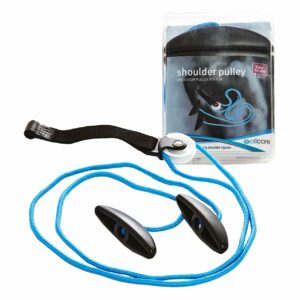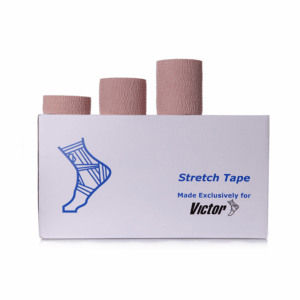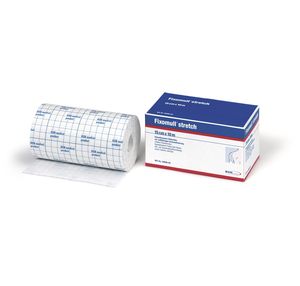Shoulder Taping
Updated:
The following shoulder taping techniques are designed to support the shoulder and reduce stress on the shoulder during sport or general activity. They can be used for both the treatment and prevention of shoulder injuries.
You should discuss the suitability of these shoulder taping techniques with your physiotherapist prior to using them. Generally, they should only be applied provided they are comfortable and do not cause an increase in pain, discolouration, pins and needles, numbness, swelling, itchiness or excessive redness of the shoulder, arm, hand, or fingers.
What sort of tape should be used to tape my shoulder?
There are many different tapes and bandages available for use by physiotherapists and patients. However, when the purpose is to restrict undesired motion, adhesive, non-stretch (rigid) sports tape is generally the most appropriate. (For shoulder strapping 38mm is usually the most appropriate size). This should always be used in combination with hypoallergenic tape as an underlay, such as Fixomull.
Benefits of Shoulder Taping
When used correctly, shoulder taping techniques can:
- Aid healing of shoulder injuries.
- Allow an earlier return to sport or activity following injury.
- Reduce the likelihood of injury aggravation.
- Prevent shoulder injuries (such as a dislocated shoulder or AC joint sprain) during high risk activities or contact sports (such as Australian Rules Football, Rugby etc.).
Indications for Shoulder Taping
It is generally beneficial to tape a shoulder in the following instances:
- Following certain shoulder injuries – Shoulder taping may be beneficial following certain shoulder injuries (such as AC joint sprain or shoulder dislocation). This should be discussed with the treating physiotherapist as certain shoulder injuries should not be taped – such as some fractures.
- To prevent injury or injury aggravation – Shoulder taping may be beneficial during sports or activities that place the shoulder at risk of injury or injury aggravation (such as football, rugby etc.).
When should I avoid Shoulder Taping?
Shoulder taping should be avoided in the following instances:
- If you have certain injuries such as some fractures (this should be discussed with the treating physiotherapist).
- If you have a skin allergy to sports tape.
- If the taping technique results in an increase in symptoms such as pain, ache, itchiness, discolouration, pins and needles, numbness, swelling or excessive redness of the shoulder, arm, hand or fingers.
- If you have sensory or circulatory problems.
Weaning off shoulder tape in general activity is usually recommended as strength, range of movement and function improves and symptoms reduce. In these instances though, shoulder strapping during high-risk activity (such as some sports) is usually still recommended.
Shoulder Taping Techniques
The following taping techniques may be used to provide support for the shoulder and are particularly beneficial following an AC joint sprain or for shoulder instability (often following dislocation), or, to prevent a shoulder injury. Generally it is recommended that the shoulder is shaved 12 hours prior to taping (to prevent painful removal of hairs and skin irritation). The skin should be cleaned and dried, removing any grease or sweat. Low irritant Fixomull tape should be applied as an under-wrap to reduce the likelihood of skin irritation with rigid sports tape over the top of this.
Some or all of these taping techniques may be applied to tape the shoulder and provide the support required for the individual.
Anchors
Begin this taping technique in good posture with the hand positioned on the hip as demonstrated (figure 2). Place a strip of tape around the upper arm keeping the biceps tense and a strip of tape from the shoulder blade to the chest (figures 1 & 2). Begin by following the black arrows and conclude by following the white arrows (figures 1& 2). This should be applied gently to prevent circulatory problems and is used as a fixation point for the other shoulder taping techniques.
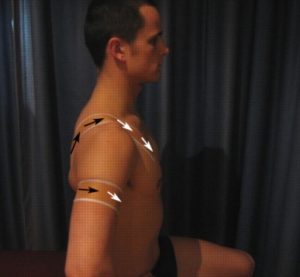
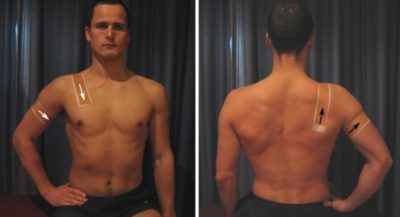
Straight Lines
Begin this taping technique in good posture with the hand positioned on the hip as demonstrated (figure 2). Start the tape at the level of the upper arm anchor at the side of the arm by following the black arrow (figure 3). Conclude this taping technique by firmly following the white arrow. Do 1 – 3 straight lines depending on the amount of support required, with each additional line partially overlapping the previous line.
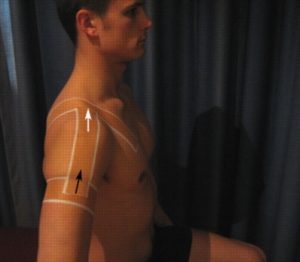
Shoulder Crosses
Begin this taping technique in good posture with the hand positioned on the hip as demonstrated (figure 2). Start the tape at the level of the upper arm anchor at the side of the arm by following the black arrows (figure 4). Conclude this taping technique by firmly following the white arrows. Two lines of tape should be used forming a cross (figure 4). Do 1 – 2 crosses depending on the amount of support required.
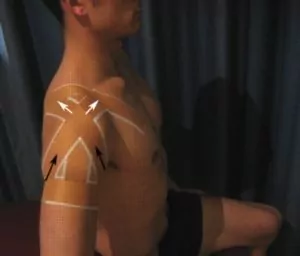
Rotational Lines

Members Only ContentBecome a PhysioAdvisor Member to gain full access to this exclusive content. For more details see Become a Member. Already a member? Login Now
Front Crosses

Members Only ContentBecome a PhysioAdvisor Member to gain full access to this exclusive content. For more details see Become a Member. Already a member? Login Now
Final Straight Lines

Members Only ContentBecome a PhysioAdvisor Member to gain full access to this exclusive content. For more details see Become a Member. Already a member? Login Now
AC Joint Taping Recipe

Members Only ContentBecome a PhysioAdvisor Member to gain full access to this exclusive content. For more details see Become a Member. Already a member? Login Now
Shoulder Taping for Anterior Shoulder Instability or following Anterior Shoulder Dislocation

Members Only ContentBecome a PhysioAdvisor Member to gain full access to this exclusive content. For more details see Become a Member. Already a member? Login Now
Removing the tape
Care should be taken when removing the tape to avoid injury aggravation or skin damage. Blunt Nosed Tape Scissors should be used. The tape should be removed slowly, pulling the tape back on itself with pressure placed on the skin as close as possible to the line of attachment of the tape.
Generally tape should be removed within 48 hours of application or sooner if there is any increase in pain or symptoms (including skin irritation or itchiness).
Shoulder Taping Summary

Members Only ContentBecome a PhysioAdvisor Member to gain full access to this exclusive content. For more details see Become a Member. Already a member? Login Now
 Physiotherapy Products for Shoulder Taping & Rehabilitation
Physiotherapy Products for Shoulder Taping & Rehabilitation
- Fixomull (Low Irritant Underlay Tape)
- Rigid Sports Tape
- Blunt Nosed Tape Scissors
- Adhesive Tape Remover
- Elastic Adhesive Bandage (EAB)
To purchase physiotherapy products to assist with shoulder strapping click on one of the above or below links or visit the PhysioAdvisor Shop.
 Shoulder Exercises
Shoulder Exercises
 Other Taping Techniques
Other Taping Techniques
 Find a Physio
Find a Physio
Find a physiotherapist in your local area who can help with shoulder taping.
 More Information
More Information
- Read about AC Joint Sprains.
- Read about Shoulder Instability.
- Read about Shoulder Dislocation.
Become a PhysioAdvisor Member
-
 Individual Membership (12 Months)$59.95 for 1 year
Individual Membership (12 Months)$59.95 for 1 year -
 Individual Membership (3 Months)$39.95 for 3 months
Individual Membership (3 Months)$39.95 for 3 months -
 Individual Membership (Yearly)$49.95 / year
Individual Membership (Yearly)$49.95 / year -
 Individual Membership (Monthly)$15.95 / month
Individual Membership (Monthly)$15.95 / month

Link to this Page
If you would like to link to this article on your website, simply copy the code below and add it to your page:
<a href="https://physioadvisor.com.au/health/taping-techniques-upper-body/shoulder”>Shoulder Taping – PhysioAdvisor.com</a><br/>PhysioAdvisor offers quality physiotherapy information on shoulder taping techniques for shoulder injuries.
Return to the top of Shoulder Taping.




